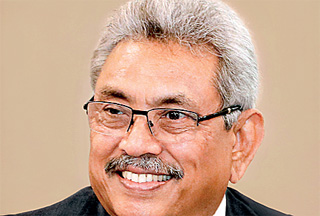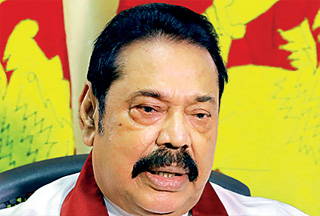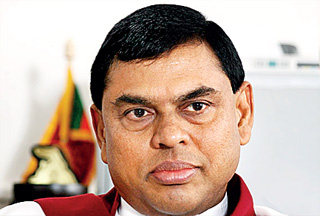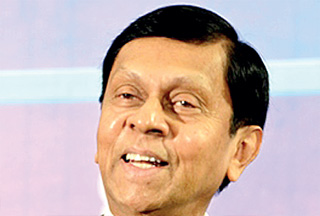Thursday Apr 17, 2025
Thursday Apr 17, 2025
Tuesday, 27 July 2021 03:05 - - {{hitsCtrl.values.hits}}

President Gotabaya Rajapaksa

Prime Minister Mahinda Rajapaksa

Finance Minister Basil Rajapaksa

Money, Capital Market and Public Enterprises State Minister Nivard Cabraal
By Nisthar Cassim
Against widespread fears and claims of default sans multilateral donor help, Sri Lanka yesterday completed the groundwork towards the settlement of $ 1 billion worth of International Sovereign Bonds (ISBs) maturing today.
The move, according to Money, Capital Market and Public Enterprises Reform State Minister Nivard Cabraal, has proved all the doomsayers and sceptics, both globally and locally, wrong.
“Right along we have been consistently saying Sri Lanka will pay despite some reckless rating agencies and analysts regularly being sceptical and unreasonably irrational. The settlement also cements the fact Sri Lanka continues its unblemished reputation of honouring its debt,” Cabraal said.
He also said that it was unfortunate that due to rating actions and analyst reports some bondholders had panicked and sold off at huge discounts. It was earlier reported that the $ 100 ISB of Sri Lanka traded at a $ 50-70 range.
“In fact, this morning several investors who kept faith personally called me and were appreciative of the fact that the Sri Lankan Government settled the maturing ISBs,” Cabraal added.
“Ultimately it is those bondholders, who went by adverse reports, who sold and lost. They must now question the credibility of such opinions these investment banks and rating agencies dished out. To ensure we honour our debt repayment, the Government took several unpopular decisions. Among those were restrictions on imports including motor vehicles. Sri Lanka and the Government certainly deserves due respect,” the State Minister pointed out.
Of the $ 1 billion, around $ 300 million of ISBs are held by Sri Lankan financial institutions and Cabraal believes a good part of it will remain within the country.
Cabraal also responded to several opposition groups which have been speculating about Sri Lanka’s forex Reserve level and attempting to convey a status of instability.
“What is most important is the cash flow, not the Reserve level at a given time,” stressed the former long-serving Central Bank Governor.
He said experienced finance managers would keep a close watch on the cash flows as they very well know that temporary fluctuations in the reserve level may occur, but that no de-stability would be caused if the cash flow was managed successfully.
“Sri Lanka has worked out its external cash flows in a manner so that every forex loan repayment and interest payment will be made on time – through the careful management of its existing reserves as well as expected inflows and outflows.”
The State Minister also revealed that the inflows over the next three months, as per the country’s forex pipeline, amounts to nearly $ 2.65 billion.
Within this pipeline are 1) $ 400 million SWAP from India, 2) $ 250 million SWAP from Bangladesh, 3) $ 300 million loan from China Development Bank, 4) $ 800 million Special Drawing Rights allocation from the IMF, 5) $ 200 million Central Bank purchases from the Forex market in the next three months, 6) $ 300 million inflow from ISBs held by local banks, and 7) $ 400 million expected inflows from the utilisation of under-utilised assets.
Cabraal said the Central Bank had also successfully negotiated a $ 1.5 billion SWAP with the People’s Bank of China which, too, could be accessed and, hence, included as a part of its effective reserves.
“In addition, arrangements are being made to roll-over almost the entirety of the SLDB and FCBU loans that are maturing over the balance part of the year, so that such maturities will not lead to a reduction in the Reserve.”
He stressed that with the repayment of the ISB today, most of the Government’s foreign debt service obligations for 2021 would have been repaid, allowing the country to replenish its reserves during the remainder of the year.
“Since the current Forex Reserve balance is at around $ 3 billion after the payment of the ISB of $ 1 billion on 27 July 2021, the available reserves within the next few months would be over $ 7 billion, when considering the expected inflows and outflows.”
Moody’s Investors Service last week placed the Government of Sri Lanka’s Caa1 foreign currency long-term issuer and senior unsecured debt ratings under review for downgrade.
“The decision to place the ratings under review for downgrade is driven by Moody’s assessment that Sri Lanka’s increasingly fragile external liquidity position raises the risk of default,” the global rating agency said.
The Finance Ministry in response expressed its surprise over the move by Moody’s and described it as “unwarranted” statement that was “ill-timed, ill-judged and hence unacceptable”.
The Government also recalled Moody’s downgraded Sri Lanka on 28 September 2020 before a $ 1 billion ISB was to mature on 4 October 2020 yet Sri Lanka successfully settled the liability without any hesitation. Finance Ministry also emphasised the need for the Government to revisit its relationship with rating agencies and invited investors to approach Sri Lankan policy authorities at the highest levels who always remain open for constructive dialogue.
The famous investment bank Goldman Sachs last week said that over the next 18 months, Sri Lanka has $ 2.5 billion in dollar bond maturities falling due, equivalent to 55% of its gross FX reserves, one of the highest levels in emerging markets. In its analysis, Goldman Sachs shared three potential scenarios for how Sri Lanka can handle its external financing needs in the near term.
Under what it described as “Muddle Through” scenario, it said Sri Lanka is able to meet its external funding needs until at least early 2021 without entering into a new IMF program, by relying on the drawdown of announced bilateral and multilateral facilities. Goldman Sachs expects Sri Lankan bond prices to continue to trade within the price ranges from March 2020 to now, with market moves dictated by news flow and investor sentiment.
Second scenario was Sri Lanka going for a fresh IMF program. Goldman Sachs said it expects Sri Lanka’s dollar bonds to perform well should the Government engage with the IMF. For example, if Sri Lankan spreads re-price to 800bp, prices for the longer-dated bonds would likely rise to above 90.
Third scenario was debt restructuring and Goldman Sachs said this may be needed if Sri Lanka is not able to muddle through and does not go to the IMF. Goldman Sachs’ earlier work on sovereign defaults would imply an NPV haircut of around 40% on external commercial debt. “This suggests downside risk to the shorter-dated bonds, with longer-dated bonds closer to fair value,” it added.
After today’s maturity, Sri Lanka will thereafter be exposed to another $ 13 billion of ISBs issued by the previous Government and repayable from 2022 to 2029.
Government sources claimed that, of these, around $ 7 billion were issued in what they claimed as a “debt issue-frenzy” of 15 months from April 2018 to June 2019.
However main Opposition Samagi Jana Balawegaya (SJB) Parliamentarian Dr. Harsha de Silva last week countered this allegation saying that in 2019 the Government had to settle two ISBs of $ 1.5 billion (the 2011 $ 1 billion ISB and the 2014 $ 500 million ISB) and that its total debt settlement in 2019 was over $ 5 billion. Therefore in 2019, Sri Lanka had to raise ISBs to roll-over the maturing ISBs.
However, in addition to raising $ 1.5 billion for this roll-over in 2019, the Government made a conscious decision to raise an additional $ 2.9 billion in ISBs in 2019 in order to provide a cushion for the next year given the potential risk to market access during the electoral cycle that year.
“It was due to this additional raising of capital that Sri Lanka had reserves of $ 7.6 billion at the end of 2019. As of now reserves have already reduced by $ 3.6 billion in 18 months to reach $ 4 billion by June 2021. In fact, if the previous Government had not raised $ 4.4 billion worth of ISBs in 2019, by now Sri Lanka would have already defaulted on its debts,” de Silva claimed.
He also said that the 2012 10-year ISB was issued at 5.8% when the US 10-year bond was trading at 1.6%. Thus, the spread between the SL ISB and the US 10 year was 4.2%. In 2018 April, Sri Lanka raised an ISB at 6.75% during which time the US 10-year yield was 2.9%. The spread between the SL ISB and the US 10 year was 3.85% – which is lower than the spread in 2012, indicating that SL had a lower risk premium in 2018 compared to 2012.
Subsequently, in October 2018 during the coup the yields on Sri Lankan ISBs increased to 10.7% by end-November 2018 and Sri Lanka was locked out of global capital markets.
“Once the legitimate Government returned to office, Sri Lanka was able to regain access to global capital markets and rates reduced from double digit levels. The last sovereign bond raised by the Sri Lankan Government was in June 2019 at 7.55%,” the SJB MP added.

Discover Kapruka, the leading online shopping platform in Sri Lanka, where you can conveniently send Gifts and Flowers to your loved ones for any event including Valentine ’s Day. Explore a wide range of popular Shopping Categories on Kapruka, including Toys, Groceries, Electronics, Birthday Cakes, Fruits, Chocolates, Flower Bouquets, Clothing, Watches, Lingerie, Gift Sets and Jewellery. Also if you’re interested in selling with Kapruka, Partner Central by Kapruka is the best solution to start with. Moreover, through Kapruka Global Shop, you can also enjoy the convenience of purchasing products from renowned platforms like Amazon and eBay and have them delivered to Sri Lanka.
Discover Kapruka, the leading online shopping platform in Sri Lanka, where you can conveniently send Gifts and Flowers to your loved ones for any event including Valentine ’s Day. Explore a wide range of popular Shopping Categories on Kapruka, including Toys, Groceries, Electronics, Birthday Cakes, Fruits, Chocolates, Flower Bouquets, Clothing, Watches, Lingerie, Gift Sets and Jewellery. Also if you’re interested in selling with Kapruka, Partner Central by Kapruka is the best solution to start with. Moreover, through Kapruka Global Shop, you can also enjoy the convenience of purchasing products from renowned platforms like Amazon and eBay and have them delivered to Sri Lanka.